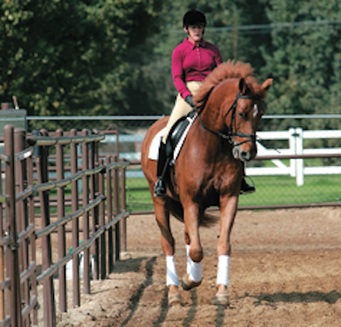How to Jump Better:
Control your own body
Olympic medalist Anne Kursinski warns us, “If we can’t control our own body, how can we expect to control our horse’s body?”
Many riders depend on their hands to maintain their own balance when a horse jumps. They lean (or sometimes even lie) on the horse's neck just as the horse is trying to rise up to clear the jump. Then they use the crop in a useless attempt to make their horse jump better.

Imagine trying to jump a course with a three-year-old child on your back.
Which would you prefer:

A child whose legs and arms are snugly in contact with your body, and who seems to know exactly how to balance her weight as you run and jump?
Photo Credit: Michael Borg Horse Jumping show – 2 flickr.com
A child whose legs and arms are snugly in contact with your body, and who seems to know exactly how to balance her weight as you run and jump?
Photo Credit: Michael Borg Horse Jumping show – 2 flickr.com

A child who holds on with a death grip and always seems to be ahead or behind your movement?
Photo Credit: Wikimedia Showjumping white horse.jpg

A child whose grip is so loosey-goosey that her legs and body slide around so she pulls you off balance at every step?
Photo credit: Girl show jumping http://www.publicdomainpictures.net/view-image.php?large=1&image=21776
A child whose grip is so loosey-goosey that her legs and body slide around so she pulls you off balance at every step?
Photo credit: Girl show jumping http://www.publicdomainpictures.net/view-image.php?large=1&image=21776
Unless you are masochist, these were rhetorical questions. So now you know how your horse feels.
Your horse would prefer you to be snugly in contact with his barrel, balanced just so as he flies over the jump, and following his neck and head movement with your hands as he jumps and canters.
Your horse would prefer you to be snugly in contact with his barrel, balanced just so as he flies over the jump, and following his neck and head movement with your hands as he jumps and canters.
You can buy every gadget, try every bit, make liberal use of your crop, work your horse over cavelletti and jumps until you are both so sour that neither of you wants to enter an arena again. But none of that will matter unless your body and the horse's body are working in unison. That requires communication between horse and rider. And that requires equitation—which essentially is what dressage is called in the hunter-jumper world.

Dressage and the art of the balanced seat
A stable and effective body position allows you to communicate and influence your horse AND to respond instantly to whatever the horse is telling you.
A stable and effective body position allows you to communicate and influence your horse AND to respond instantly to whatever the horse is telling you.
Kursinski describes a stable and secure seat this way: The ideal rider position is like a deeply rooted tree with a strong, solid base supporting free-flowing branches—your legs and seat being the trunk and upper body and arms and hands being the branches. It’s a position to be maintained regardless of what the horse is doing. It needs to be flexible enough to go with the horse when called for yet strong enough to withstand the horse’s tendency to try to pull you into a less effective position.
You need to maintain this feel even when in two-point. As Kursinski points out, slowing or bringing horses to a halt is not about the hands. It is about engaging your core muscles. Without this, your horse will pull you forward into an ineffective position, or will run through your hands, becoming stronger and less controllable as you continue through a jump course.
If you doubt that it is possible to do this when jumping (or even when in two-point), watch this video. It will change the way you think about jumping forever.
If you doubt that it is possible to do this when jumping (or even when in two-point), watch this video. It will change the way you think about jumping forever.
|
Dressage emphasizes an effective body position that allows you to communicate and influence your horse AND to respond instantly to whatever the horse is telling you. It all starts with steady, relaxed breathing. “Horses know more about us than we think they do, and our breathing tells them a lot about what’s going on with us," Kursinski notes.
|
One exercise that Kursinski emphasizes is shoulder-in. She describes it as the go-to exercise for getting a horse to round his frame naturally. The problem is that many riders believe shoulder-in means cranking the horse's neck toward the inside of the arena. It doesn't. “Done right, the horse has to use his back and hind legs, which will make him naturally round", she points out. "It’s not about pulling his head down.” The effectiveness of shoulder-in is that it establishes a connection between inside leg and outside rein. “Used properly, this is like yoga or Pilates for horses,” she notes.
I would add that shoulder-in is a fairly advanced exercise that should not be attempted right off the bat. Instead, it is better to start with shoulder-fore and leg-yielding, then advance to shoulder-in. Your horse will thank you for it.
Here are step-by-step instructions on how to learn each of these skills:
Happy riding!
Copyright Denise Cummins, PhD May 5, 2016; updated June 2, 2024
The Thinking Equestrian
Opening Photo Credit: Wikimedia TeenyTune, File:Cross gué.jpg
Here are step-by-step instructions on how to learn each of these skills:
- Three secrets to a secure seat
- How to improve your automatic release
- How to use the half halt to control your horse's speed
Happy riding!
Copyright Denise Cummins, PhD May 5, 2016; updated June 2, 2024
The Thinking Equestrian
Opening Photo Credit: Wikimedia TeenyTune, File:Cross gué.jpg


